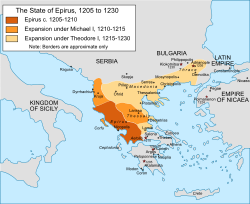Despotate of Epirus Δεσποτᾶτον τῆς Ἠπείρου (Medieval Greek) | |||||||||||||||
|---|---|---|---|---|---|---|---|---|---|---|---|---|---|---|---|
| 1205–1337 1356–1479 | |||||||||||||||
Coat of arms of Carlo I Tocco, founder of the last ruling dynasty of Epirus, as count of Cephalonia (dexter) and despot of Epirus (sinister)
| |||||||||||||||
 Epirus in 1205–1230 | |||||||||||||||
| Status | Rump state of the Byzantine Empire | ||||||||||||||
| Capital | Arta (1205–1337/40, 1430–49) Ioannina (1356–1430) Angelokastron (1449–60) Vonitsa (1460–1479) | ||||||||||||||
| Common languages | Greek | ||||||||||||||
| Religion | Greek Orthodoxy[1] | ||||||||||||||
| Government | Monarchy | ||||||||||||||
| Despot of Epirus | |||||||||||||||
• 1205–1214 | Michael I Komnenos Doukas | ||||||||||||||
• 1448–1479 | Leonardo III Tocco | ||||||||||||||
| Historical era | High Medieval | ||||||||||||||
• Established | 1205 | ||||||||||||||
• Byzantine conquest | 1337 | ||||||||||||||
• Re-establishment by Nikephoros II Orsini | 1356 | ||||||||||||||
| 1479 | |||||||||||||||
| Currency | Denier | ||||||||||||||
| |||||||||||||||
| Today part of | Albania Bulgaria Greece North Macedonia | ||||||||||||||
The Despotate of Epirus (Medieval Greek: Δεσποτᾶτον τῆς Ἠπείρου) was one of the Greek successor states of the Byzantine Empire established in the aftermath of the Fourth Crusade in 1204 by a branch of the Angelos dynasty. It claimed to be the legitimate successor of the Byzantine Empire during the subsequent struggle for Constantinople, along with the Empire of Nicaea and the Empire of Trebizond; its rulers briefly proclaiming themselves as Emperors in 1227–1242 (during which it is most often called the Empire of Thessalonica). The term "Despotate of Epirus" is, like "Byzantine Empire" itself, a modern historiographic convention and not a name in use at the time.
The Despotate was centred on the region of Epirus, encompassing also Albania and the western portion of Greek Macedonia and also included Thessaly and western Greece as far south as Nafpaktos. Through a policy of aggressive expansion under Theodore Komnenos Doukas the Despotate of Epirus also briefly came to incorporate central Macedonia, with the establishment of the Empire of Thessalonica in 1224, and Thrace as far east as Didymoteicho and Adrianople, and was on the verge of recapturing Constantinople and restoring the Byzantine Empire before the Battle of Klokotnitsa in 1230 where he was defeated by the Bulgarian Empire. After that, the Epirote state contracted to its core in Epirus and Thessaly, and was forced into vassalage to other regional powers. It nevertheless managed to retain its autonomy until being conquered by the restored Palaiologan Byzantine Empire in ca. 1337. In the 1410s, the Count palatine of Cephalonia and Zakynthos Carlo I Tocco managed to reunite the core of the Epirote state, but his successors gradually lost it to the advancing Ottoman Empire, with the last stronghold, Vonitsa, falling to the Ottomans in 1479.
- ^ Melton, J. Gordon (2014). Faiths Across Time: 5,000 Years of Religious History [4 Volumes]: 5,000 Years of Religious History. ABC-CLIO. p. 800. ISBN 9781610690263.
Constantinople (ruled by Roman Catholics) is now surrounded by a number of relatively small competing states including Bulgaria, the empire of Nicea (Greek Orthodox), the despotate of Epirus (Greek Orthodox), and the sultanate of Rum (Sunni Islam).
